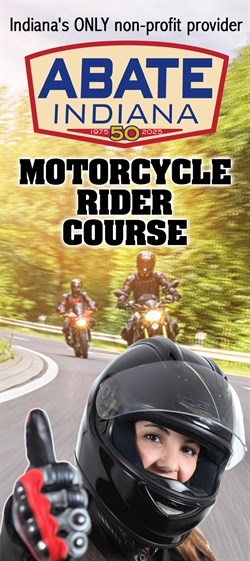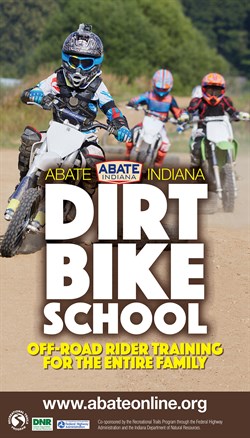|
If you would like to get your motorcycle endorsement without taking a motorcycle rider course, you are required to get your motorcycle learner's permit from the Indiana Bureau of Motor Vehicles and pass a riding test.
Below are ABATE of Indiana's testing locations, dates, and times. There is no pre-registration for license testing at our locations. For other testing locations, please check RideSafeIndiana.com.
NOTE: Tests are given on a first-come, first-served basis. You must provide your own vehicle for testing (motorcycle or trike).
Bring $40 cash (exact change), photo ID, a valid permit, and a DOT-approved motorcycle helmet (eye protection if you are under 18). Parent/guardian signature required for applicants under 18. Dates, times, and locations subject to change without notification. Questions? Call (800) 232-2283 or (317) 422-8040.
2025 ABATE Motorcycle Testing Schedule Applicants must have a valid Indiana Motorcycle learner's permit as well as a photocopy of that permit, their driver's license, a signed waiver for the BMV, a signed waiver for ABATE (both available on this page), and $40 cash. Applicants should write their phone number and email address on the photocopy of the permit. Applicants must wear a DOT-approved helmet and provide their own registered, street-legal motorcycle capable of passing a safety inspection. Riders may be asked to show proof of insurance and vehicle registration.
All motorcycle license examination applicants will receive a complimentary one-year membership in ABATE of Indiana.
IMPORTANT! These locations are private property, and practicing is prohibited. |
||
| Testing Site & Location | Notes |
Testing Dates & Times
|
|
Clarksville CC Powersports |
Sign-up for skills tests begins at the posted time and will remain open for one hour. All signed-in applicants will be tested. |
Sign-in time: 5:30 pm
March 31, Monday
April 28, Monday
May 19, Monday
June 23, Monday
July 28, Monday
August 25, Monday
September 29, Monday
October 27, Monday
SCHEDULE SUBJECT TO CHANGE WITHOUT NOTICE |
|
Evansville Roberts Park |
Testing begins at 2 pm. All those signed up by 2 pm will be tested. |
Sign-in time: 1-2 pm (central time)
You must be signed in by 2 pm to test. April 13, Sunday
April 27, Sunday
May 25, Sunday
June 8, Sunday
June 22, Sunday
July 13, Sunday
July 27, Sunday
August 10, Sunday
August 24, Sunday
September 14, Sunday
|
|
Fort Wayne Coliseum Bingo |
Sign-up for skills tests begins at the posted time and will remain open for one hour. All signed-in applicants will be tested. |
Sign-up time: 4 pm – 5 pm April 11, Friday April 25, Friday May 2, Friday May 16, Friday June 6, Friday June 20, Friday July 11, Friday July 25, Friday August 8, Friday August 22, Friday September 5, Friday September 19, Friday October 3, Friday
SCHEDULE SUBJECT TO CHANGE WITHOUT NOTICE |
|
Granger Indiana Toll Road Concession Building 52551 Ash Road |
Sign-up for skills tests begins at the posted time and will remain open for one hour. All signed-in applicants will be tested. |
Sign-in time: 2 pm April 19, Saturday April 26, Saturday May 3, Saturday May 17, Saturday May 31, Saturday June 7, Saturday June 21, Saturday June 28, Saturday July 12, Saturday August 2, Saturday August 23, Saturday September 6, Saturday September 13, Saturday September 27, Saturday October 4, Saturday October 11, Saturday
(revised 092325) SCHEDULE SUBJECT TO CHANGE WITHOUT NOTICE |
|
Indianapolis Marine Corps League |
Sign-up for skills tests begins at the posted time and will remain open for one hour. All signed-in applicants will be tested. |
Sign-in time: 4 pm May 3, Saturday May 17, Saturday May 18, Sunday June 7, Saturday June 28, Saturday June 29, Sunday July 12, Saturday July 26, Saturday August 2, Saturday August 9, Saturday August 10, Sunday September 6, Saturday September 14, Sunday October 12, Sunday
(revised 091525)
SCHEDULE SUBJECT TO CHANGE WITHOUT NOTICE |
|
Kokomo Inventrek Technology Park |
Sign-up for skills tests begins at the posted time and will remain open for one hour. All signed-in applicants will be tested. |
Sign-in time: 4 pm April 6, Sunday May 4, Sunday May 18, Sunday June 1, Sunday June 15, Sunday July 6, Sunday July 20, Sunday August 3, Sunday August 17, Sunday September 7, Sunday September 21, Sunday October 5, Sunday October 19, Sunday
(revised 040425)
SCHEDULE SUBJECT TO CHANGE WITHOUT NOTICE |
|
Merrillville IUOE Local 150
|
Sign-up for skills tests begins at the posted time and will remain open for one hour. All signed-in applicants will be tested. |
Sign-in time (Saturdays): 2 pm (central)
Testing begins at 3 pm April 12, Saturday
April 26, Saturday
May 10, Saturday
May 24, Saturday
June 7, Saturday
June 21, Saturday July 13, Sunday (sign-up at noon, test at 1 pm) July 26, Saturday August 16, Saturday August 30, Saturday September 13, Saturday
September 27, Saturday
October 4, Saturday
October 11, Saturday
October 25, Saturday
(revised 101025)
SCHEDULE SUBJECT TO CHANGE WITHOUT NOTICE |
|
Terre Haute Thompson's Motorsports 250 W Honey Creek Pkwy Terre Haute, IN 47802
|
Sign-up for skills tests begins at the posted time and will remain open for one hour. All signed-in applicants will be tested. |
Sign-in time (Saturdays) 10 am Sign-in time (Sundays): 2 pm
May 24, Saturday
May 25, Sunday
June 14, Saturday
June 15, Sunday
July 12, Saturday
August 2, Saturday
August 3, Sunday
September 14, Sunday
September 20, Saturday
September 21, Sunday
(revised 071325)
SCHEDULE SUBJECT TO CHANGE WITHOUT NOTICE |
|
Versailles Southeastern Career Center |
Sign-up for skills tests begins at the posted time and will remain open for one hour. All signed-in applicants will be tested. |
Sign-in time: 10:00 am
March 30 April 6 April 20 May 4 May 11 July 6 July 20 August 10 August 24 October 19
(revised 100225)
SCHEDULE SUBJECT TO CHANGE WITHOUT NOTICE |
|
|
|
|
|
|
||
|
|
||
Testing Requirements:
• Fee: $40.00 CASH, payable to examiner at the time of testing.
• You must provide an Indiana Drivers License.
• You must have a valid (unexpired) Motorcycle Learner's Permit (permit test administered by the Bureau of Motor Vehicles and based on questions from the Motorcycle Operators Manual.)
• Applicant must provide their own vehicle (motorcycle or trike).
• Motorcycle used for skills examination to obtain an endorsement or license must be street-legal, currently registered, with proof of insurance.
• Motorcycles are subject to a vehicle safety inspection performed by the examiner.
• Applicant must wear a DOT approved motorcycle helmet.
• Minors MUST be accompanied by a parent to test.
Important BMV links:
Indiana Motorcycle Endorsement
Indiana Motorcycle Learners Permit


